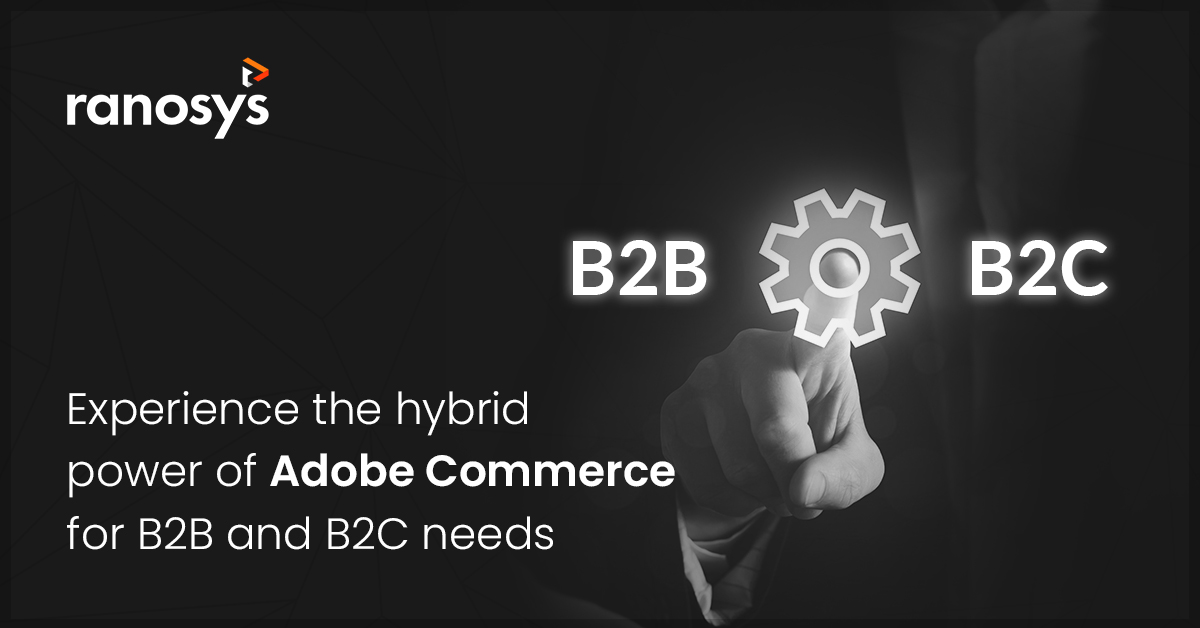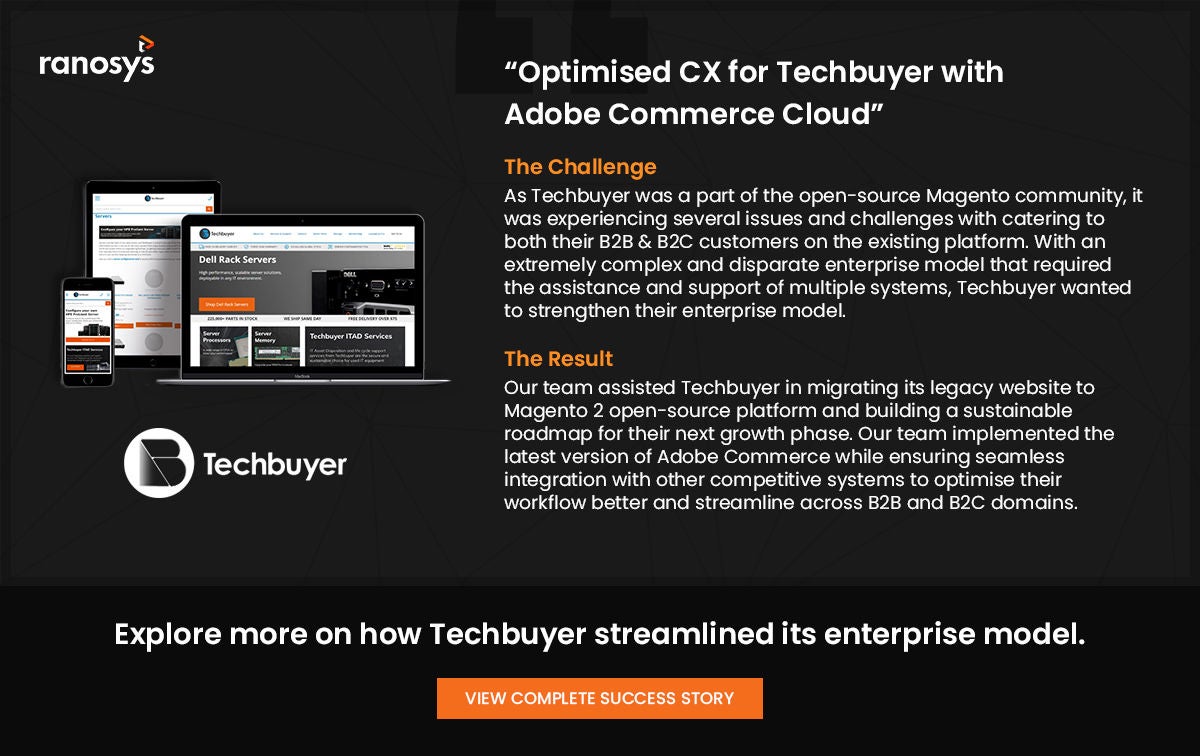You’re ready to expand your business and explore new channels. That can entail expanding your B2C company to include a wholesale division, or you might already be a B2B eCommerce company prepared to sell directly to customers. In either case, you require a new set of eCommerce features. Your choices are either transferring to a new “hybrid” platform that combines complete B2B and B2C feature sets or making significant customisations to your current platform.
A hybrid eCommerce solution allows you better adaptability to take advantage of the next technological disruption to your industry. A unified catalogue management feature provided by B2B B2C hybrid eCommerce platform enables you to track all your products in one place. This hybrid platform also helps you keep your options open and makes it simpler to experiment with new methods whenever your business is ready.
And that’s where a platform like Adobe Commerce Cloud hybrid platform can help. The customer journey is optimised using this adaptable, scalable hybrid commerce platform from the first click-through to the checkout and beyond.
How does Adobe Commerce Cloud allow B2B and B2C selling together
Magento Commerce B2B B2C hybrid functionalities allow all businesses to thrive. Here are a few points on how Adobe Commerce Cloud helps B2B B2C eCommerce manufacturers selling direct-to-consumer:
#1: One platform to support both B2B and B2C hybrid eCommerce goals
With Adobe Commerce, you don’t have to maintain two separate eCommerce platforms for your B2B and B2C needs, which often requires duplicated efforts and increases budgets. Since both the platforms will share capabilities to deliver superior commerce experiences to B2B and B2C hybrid buyers, housing them in an Adobe Commerce system will help you improve operational efficiency and personalization capabilities.
#2: Competitive features for B2B eCommerce customers, the B2C way
As a solid hybrid eCommerce platform, Adobe Commerce Cloud possesses competitive features such as customer-specific catalogues and pricing, volume discounts, custom taxation rules for B2B buyers, easy reordering, flexible and mobile-optimised payment and checkout, automate price quote requests and negotiation with buyers, B2B specific reporting, automated cross-selling and up-selling opportunities, easy shipping solutions, and convenient account management to provide users with self-service portals to easily access invoices, order history, available company credits, and manage permissions.
Your buyers indulge in frictionless buying experiences by either entering SKUs, CSV file uploads, or picking from an existing requisition list to create orders within minutes or troubleshoot any issues.
#3: Easy content updates with Page Builder
For both B2B and B2C companies, updating content is a tedious job. With Adobe Commerce Page Builder, you can accelerate content creation and even get your non-technical teammates to create new pages, update old ones, preview designs, and publish these pages without having to write a single line of code. Since Adobe Commerce supports customer segmentation, only relevant content would be visible to your audiences, depending on whether they are B2B or B2C or hybrid buyers.
#4: Boost performance with Adobe Experience Manager CMS platform
This powerful CMS platform combines the capabilities of a sophisticated content management system along with the competitiveness of digital asset management. As Adobe Experience Manager seamlessly integrates with your Adobe Commerce storefront to suffice both B2B and B2C hybrid customers’ needs, it empowers you to create personalised content as per your target users across touchpoints and lead content-led experiences that scales as your business grows.
Other features of Adobe Experience Manager include advanced SEO tools for producing meta descriptions and URLs that are search engine-friendly, easy drag-and-drop functionalities to create, update, and deploy content pages without the need of a front-end developer, and workflow management for content creation, approval, and sharing.
#5: Rich mobile experiences via Progressive Web Apps (PWA)
When it comes to offering rich native-like B2B B2C hybrid eCommerce experiences across desktop and mobile touchpoints, the popularity of PWAs is surmounting. There was a time when businesses could rely on responsive web designs and native apps to ensure superior desktop and mobile experience. However, the tediousness of developing and maintaining such apps for all mobile operating environments have forged the way for Progressive Web Apps. This headless commerce technology blurs the line between mobile apps and mobile sites, offering rich app-like experiences within mobile browsers.
With Magento PWA Studio, you can develop, deploy, and maintain a PWA storefront while extending consistent experiences across smartphones, tablets, and desktops for both B2B and B2C hybrid commerce. The best part, with Adobe Commerce PWA Studio, you empower your users to access your product catalogues and shop even via unstable network/internet connectivities. With faster UI/UX navigation and reduced development costs, Adobe Commerce helps you secure both aspects of your B2B and B2C hybrid business.
#6: Multi-channel capabilities to support B2B and B2C customers
As a hybrid eCommerce solution, Adobe Commerce blends physical and online selling into a single unified customer experience as a part of its multi-channel capabilities. With Adobe Commerce Cloud, retailers can:
- Offer comprehensive listing and inventory management across marketplaces
- Support closely knit digital and in-store shopping experiences like buy online/pick up in store, digital kiosk, and endless aisle strategies in stores and warehouses
- Leverage smart and flexible fulfilment methods to reduce shipping costs and wait times
- Provide account management permits that allow B2B eCommerce sales reps to place orders on behalf of the customers
#7: Unrivalled performance throughout
B2C eCommerce brands that offer lightning-fast loading times, superior security, and consistent experiences especially during peak traffic times are crowned as the best hybrid eCommerce platform. Therefore, when you start selling B2C along with B2B, you need to work on your page load speeds and choose an infrastructure that is reliable and grows along with your business. With Adobe Commerce Cloud as your hybrid eCommerce solution, you offer unrivalled performance, flexible server capacity, and a secure checkout experience guarded against frauds and cyberattacks. Adobe Commerce easily implements security tools like DDoS protection and web application firewall to keep your B2B B2C hybrid commerce store protected and well-performing at all times.






